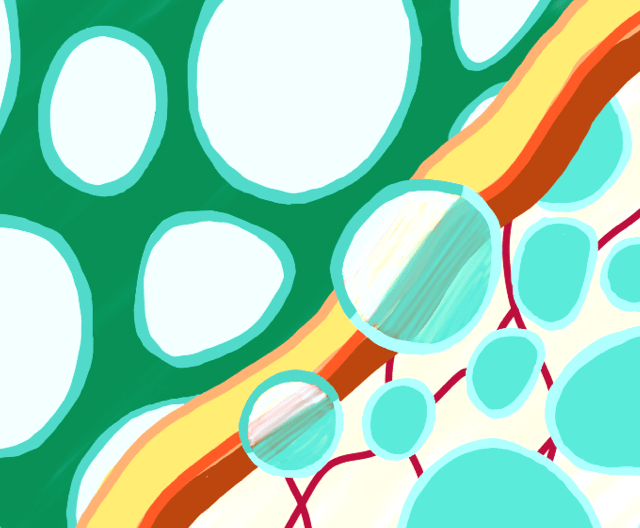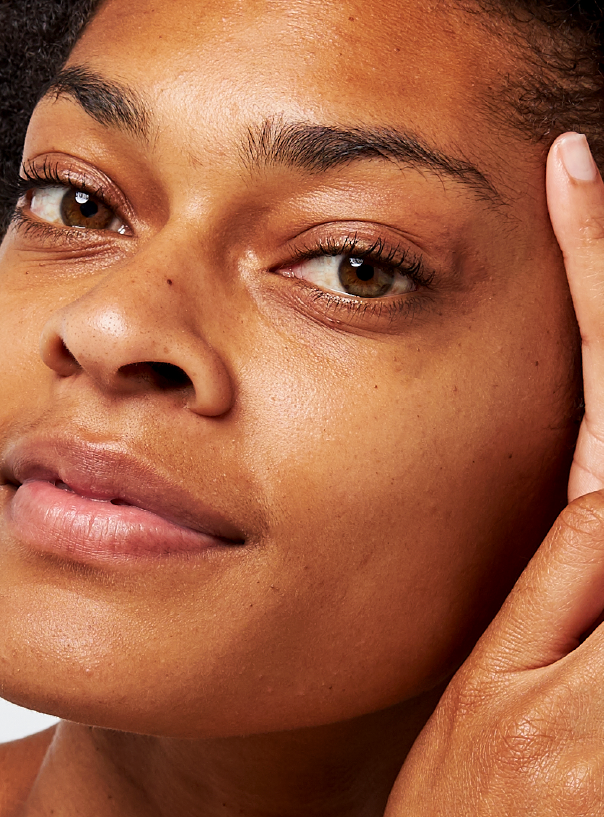Deep Dives
Does Your Body Absorb 60% of Your Skincare?


SHARE
Deep Dives
Does Your Body Absorb 60% of Your Skincare?
Medically reviewed by Aimee Paik, MD
Written by Lisa Guerrera
Last updated 4/6/2022
Imagine a world where you’d never have to get a shot at the doctors again. A world where taking a bath or going swimming for too long could be fundamentally dangerous to your health. Even a world where you wouldn’t need to actually eat or drink water, instead you could slather it onto your skin absorbing the nutrients like some kind of monstrous, messy sponge.
But... we know that baths aren’t dangerous, pools are safe, and food is decisively ingested.
That’s why one of the most common misconceptions in skincare is the idea that our skin absorbs 60% of what we put on it. A quick google search yields pages and pages of brands and other organizations claiming this stat in one way or another. Googling one quote, “26 seconds is all it takes”, yields a scammy looking mountain of “yikes” inducing misinformation that claims the chemicals in your personal care products will enter your bloodstream in just 26 seconds. On its surface, these stats might make sense: Your products have to go somewhere right? Is there any science that backs these up?
As I was reading through an “organic & natural” health food store article with remarkably high SEO and I finally found the original 1984 (👀) paper this “60%” stat is based off of. It shows that on average 64% of the volatile compounds in question were absorbed via the skin. Sounds pretty scary but let’s unpack why that’s you shouldn’t worry about that with your skincare. The TL;DR is that you can't compare the chemicals in this study (contaminated groundwater) with the chemicals in a tested skincare product on your bathroom shelf.
First, let’s get our terms straight. When we discuss “penetration” of an ingredient, it’s referring to an ingredient’s ability to enter the different layers of the skin. Some ingredients can’t penetrate, some ingredients can get into the stratum corneum, some deeper into the epidermis, and a few can get to the dermis. “Absorption” is definitive– it refers to a chemical entering the bloodstream. In order for a chemical to absorb into the body, it needs to penetrate down to the dermis at least.
The skin’s main job is to protect the body from the outside world. It’s actually waterproof with a super unique lipid barrier that helps create that waterproofing quality. One of the greatest challenges when it comes to skincare formulation is how do you get the product’s actives to penetrate the skin? There are a few factors involved:
Your skin ✋
First things first: let’s talk about your skin biology. Your body actually has different types of skin all around. The soles of your feet have very different skin than your eyelids for instance. Skin can have different thicknesses and have different features that can affect it’s penetrability and subsequently, absorption depending on the area. A handy chart that PhD Chemist and beauty blogger, Michelle Wong of LabMuffin, summarized from a cool textbook, shows that location on the body matters! But that’s not the only factor...
The molecule 🧪
The molecule of the ingredient has two primary factors that affect its absorption: size and polarity (you know–like dissolves like). The smaller the molecule, the better it can penetrate and potentially be absorbed. The other major factor is whether the molecule is hydrophilic (water-loving) or hydrophobic (oil-loving). These properties can help the molecule navigate the complex layers of skin that contain both hydrophilic and hydrophobic molecules.
Formulation 🧴
An even more important point is that individual chemicals don’t exist in a vacuum. Your skincare products usually have many ingredients in many different concentrations, combinations, and formulation delivery systems. There are many ways chemists can modify ingredient penetration with ingredients that can inhibit or enable other ingredients to penetrate the skin further. Some ways include changing the pH, using specific active ingredients, using ingredients called “penetration enhancers” like alcohol, and using different emulsion ratios (ex: a formula that’s 75% oil and 25% water).


Occlusion 〰️
Occlusion essentially means covering the skin with an impermeable barrier. This helps ingredients penetrate deeper into the skin by reducing evaporation and increasing the hydration of the skin’s upper layers. This is one of the theories behind sheet mask popularity– you're using a covering to occlude the skin, which potentially increases the penetration of the mask's ingredients. Dermatologists often prescribe occlusive ointments for eczema, that have the dual purpose of helping medication penetration while also protecting damaged skin. Win-win!
Physical Methods 🏋️
We’ve talked a lot about chemical properties and their effect on skin penetration, but physical methods play a big role too. Exfoliation, both chemical and physical, can increase penetration potential of certain ingredients since there are less dead skin cells to get in the way. Other examples are micro-dart pimple patches, like Zitsticka, that physically penetrate the top layers of skin with crystalized hyaluronic acid micro needles. The point is to deliver ingredients deeper in the skin so they can reach a pimple that hasn’t ‘come to a head’ yet. The need for micro needle products illustrates how hard it is for ingredients to penetrate!
Skin Health ⚕️
Lastly, skin health plays a crucial role in ingredient absorption too. Folks with strong, resilient skin with a healthy skin barrier will usually see less absorption of ingredients than folks with damaged skin barriers or with conditions like eczema. The skin barrier is the skins first defense, so the stronger the barrier, the harder it is for ingredients to get through.
So… is ingredient absorption always bad? 🧐
Popular opinion seems to suggest that it’s automatically a bad thing, but to be clear, there are MANY instances that ingredients can be absorbed into the bloodstream that do not result in harm! Tretinoin (a form of vitamin A) is usually absorbed between 1-2% from facial application on healthy skin. That means about 0.00025 - 0.0005% of your tretinoin could potentially be absorbed into the body. Tretinoin is a perfectly safe topical treatment, so just because it’s absorbed doesn’t mean it’s bad!
More than meets the 👁️
It’s important for us to be critical of ourselves when our gut instinct might tell us: “Hey! My skincare is “sinking into” my skin, it must be going somewhere right?” We might assume that “somewhere” is inside our bodies when, most of the time, skincare is either just penetrating into the stratum corneum (and not much further) or it’s evaporating off. Skincare, in general, contains a fair amount of water so that will usually evaporate off depending on the formula.
So are the rumors true? Not really. While it’s true, some ingredients can potentially absorb into our bodies up to 60%, most don’t! With so many ways cosmetic chemists and dermatologists can inhibit or enhance absorption, you can’t look at all cosmetics and make that blanket statement. So, next time you see this phrase regurgitated, know that it isn’t true and feel free to slather (😉) on your favorite lotion in peace.
Shop this post

Tretinoin
Like what you just read? Sign up for our email list to get the scoop on skincare science delivered straight to your inbox.

Education
What is milia?
What is milia? Today, we’re jumping into one type of bump that you may have heard about most commonly in infants — milia.
Read More
Education
Best moisturizer for acne-prone skin
If you have combination acne-prone skin, figuring out which moisturizer is best for your skin might be tough. In this guide, we break down the best moisturizer for combination, acne-prone skin.
Read More
Education
How to build a face care routine
As you get into skincare, it might seem overwhelming, especially trying to figure out the order you're supposed to apply products in. Below, we detail how to build a face care routine for your skin!
Read More